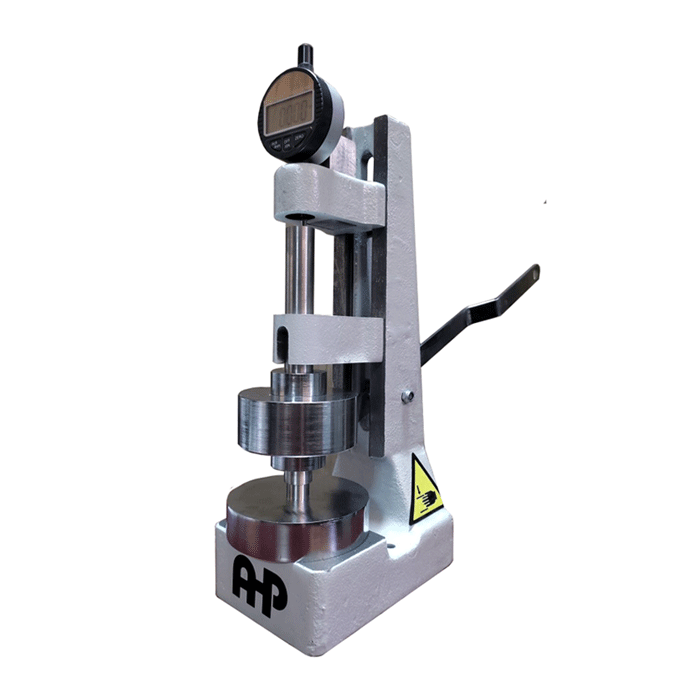6 Apparatus
6.1 Thickness Testing Instrument —The thickness gauge shall have a base (or anvil) and a free moving presser foot plate whose planar faces are parallel to each other to <0.01 mm. A gauge with a 56.4 mm (2.22 in.) diameter presser foot, the base shall extend at least 10 mm in all directions further than the edge of the 2500 mm2 circular pressor foot, shall be used for measurements of geotextiles, geocomposite drainage materials, and geonets. A gauge with a 6.35 mm (0.250 in.) diameter pressor foot shall be used for laboratory measurements of geomembranes. A gauge with 6.35 mm (0.250 in.) diameter pressor foot and base may be used for field measurements of geomembrane thickness. The instruments must be capable of measuring a maximum thickness of at least 10 mm to an accuracy of at least 60.02 mm. The gauges shall be constructed to permit gradual application of pressure to a specific force of 2 ± 0.02 kPa (0.29 ± 0.003 psi) for geotextiles and 20 ± 0.2 kPa (2.9 ± 0.03 psi) for geomembranes. Dead-weight loading may be used.
6.1.1 The specified force of 20 kPa may be inadequate for some HDPE geomembranes. A pressure in the range of 50 to 200 kPa is recommended for HDPE geomembranes if fictitiously high readings are suspected using the 20 kPa pressure.
NOTE 2—(Appendix X1) lists some of the suppliers of apparatus for thickness measurement.
6.2 Cutting Dies—Dies to cut specimens should have dimensions at least as large as a circle of 75 mm (3 in.) diameter.
NOTE 3—Due to the compressibility of many geotextiles and geomembranes, the cutting and handling preparation may change the thickness.
Care should be exercised to minimize these effects.
9 Procedure
9.3 Procedure A – Geotextiles, Geocomposite Drainage Materials, and Geonets: With the force applied to the pressor foot on the base (no test specimen present), zero the measuring scale or record the “base reading.” Lift the presser foot, center the test specimen on the base under the presser foot, and bring the presser foot into contact with the material. Gradually increase the pressure to 2 kPa (0.29 psi). After the full force has been applied to presser foot for 5 s against the specimen, record the thickness value to the nearest 0.02 mm and remove the specimen from the test device.
9.4 Procedure B – Smooth Surfaced Geomembranes: With the force applied to the pressor foot on the base (no test specimen present), zero the measuring scale or record the “base reading.” Lift the presser foot, center the specimen on the base under the presser foot, and bring the presser foot into contact with the material. Gradually increase the pressure to 20 kPa (2.9 psi). After the full force has been applied to presser foot for 5 s against the specimen, record the thickness value to the nearest 0.02 mm and remove the specimen from the test device.

- 56.4 mm diameter presser foot
- Pressure application of 2 and 20 KPa
- According to ASTM D5199
